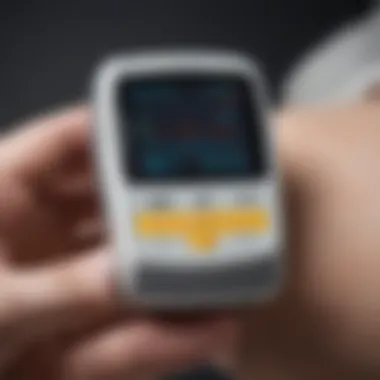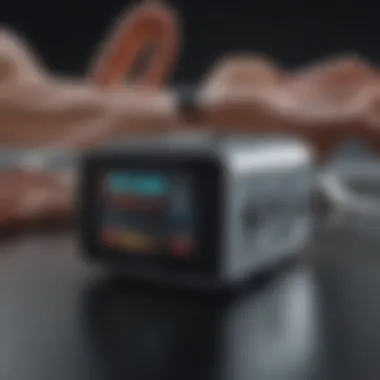Enhancing COPD Management with Pulse Oximetry


Intro
Chronic obstructive pulmonary disease (COPD) affects millions of individuals worldwide, presenting substantial challenges in terms of management and patient care. Its complexities require sophisticated diagnostic tools to monitor and optimize treatment strategies. Among these tools, pulse oximetry stands out. It not only aids in understanding a patient's respiratory status but also plays a pivotal role in guiding therapeutic interventions. Thus, a closer examination into how pulse oximetry intertwines with COPD management is both timely and necessary.
Research Overview
Key Findings
Recent studies underscore that pulse oximetry remains an essential aspect of COPD management. There are several key insights from the literature:
- Early detection of hypoxemia: Utilizing pulse oximetry enables clinicians to swiftly identify low oxygen saturation levels, crucial for timely interventions.
- Monitoring disease progression: Regular assessments can reveal shifts in oxygen levels, helping in the evaluation of disease status.
- Informed treatment decisions: Data from pulse oximetry can influence choices regarding oxygen therapy, medications, and lifestyle adjustments.
In practice, these findings suggest that effective monitoring through pulse oximetry not only enhances patient outcomes but also supports personalized treatment approaches.
Study Methodology
Various methodologies have been employed in researching pulse oximetry’s role in COPD:
- Longitudinal studies that follow patients over time to assess how continuous monitoring impacts clinical decisions.
- Controlled trials comparing standard care with care supplemented by integrated pulse oximetry readings.
- Surveys and qualitative research gathered from healthcare providers to understand their perspectives on the utility of pulse oximetry in everyday practice.
Through these investigations, a clearer picture emerges, establishing pulse oximetry's undeniable value within clinical settings.
Background and Context
Historical Background
The origins of pulse oximetry can be traced back to the 1970s, a period marking significant advancements in medical technology. Initially developed to assist in monitoring surgical patients, it soon found applications in various respiratory conditions. Over the decades, its evolution has seen refinements in technology and application, particularly in relation to COPD, where oxygenation plays a vital role in patient management.
Current Trends in the Field
Today, there's a marked shift towards integrating pulse oximetry with telemedicine, allowing remote monitoring of patients with COPD. This trend is driven by the increasing demand for managing chronic diseases from home, especially in light of broader healthcare shifts towards patient-centered care. As a result, devices are being designed with improved portability and ease of use, enabling patients to take an active role in their health management.
Understanding these trends can help clinicians and researchers devise strategies for more effective patient engagement and treatment optimization in the context of COPD.
"Pulse oximetry has transcended traditional boundaries, becoming a cornerstone in the ongoing battle against COPD. Its role in patient care continues to evolve, paving the way for innovative approaches in managing this prevalent disease."
This article will delve deeper into the interplay between pulse oximetry and COPD, elucidating how this tool can enhance clinical practice and improve patient outcomes.
Prelims to Chronic Obstructive Pulmonary Disease
Chronic Obstructive Pulmonary Disease (COPD) stands as a leading cause of chronic morbidity and mortality worldwide. For both patients and healthcare professionals, understanding COPD is crucial. It paves the way for effective management and better patient quality of life. This section addresses the fundamental components of COPD, shedding light on its implications that extend beyond the physical limitations of the disease.
Understanding COPD
COPD is not merely a respiratory issue; it encompasses a range of conditions, mainly emphysema and chronic bronchitis. Both conditions contribute to airflow obstruction, but their causes and effects diverge. Emphysema involves the destruction of the air sacs in the lungs, leading to decreased oxygen exchange and breathlessness. Chronic bronchitis, on the other hand, is characterized by chronic inflammation of the airways, producing excess mucus and leading to persistent coughing. Understanding these nuances is essential for implementing appropriate therapies aimed at alleviating symptoms.
The pathology of COPD often stems from environmental factors, primarily smoking, though non-smokers can also develop the disease due to factors like air pollution or genetic predisposition. Early diagnosis and intervention are key to slowing disease progression and improving quality of life.
Epidemiology of COPD
The statistics surrounding COPD are quite sobering. According to the World Health Organization, COPD will become the third leading cause of death globally by 2030 if current trends continue. In the U.S. alone, an estimated 16 million adults have been diagnosed with COPD, with millions more potentially undiagnosed.


Various factors contribute to the prevalence of COPD:
- Age: It predominantly affects older adults, particularly those aged 65 and above.
- Sex: Historically, men had higher rates of COPD, but as more women smoke, the gap narrows.
- Geography: Regions with high levels of air pollution and inadequate healthcare access tend to report higher incidence rates.
Knowing the population at risk helps target preventive measures and allocate healthcare resources effectively.
Pathophysiology of COPD
To grasp the challenges posed by COPD, one must delve into its pathophysiological mechanisms. Impaired airflow and gas exchange are integral to COPD's pathology. This impairment results from inflammation and structural changes in the lungs. Specifically, the inflammatory process leads to:
- Bronchoconstriction: Narrowing of the airways enhances breathing difficulty.
- Hypersecretion of mucus: Excessive mucus hinders airflow, which can exacerbate chronic cough.
- Destruction of alveoli: This reduces effective surface area for gas exchange, contributing to hypoxemia.
These elements contribute to the typical symptoms of COPD, such as dyspnea, chronic cough, and wheezing. Furthermore, the interplay of these factors means complications are common, impacting not just respiratory health but overall wellbeing. Understanding these pathophysiological processes is pivotal in developing effective strategies for patient care and intervention.
"COPD is not just a lung disease; it is a complex interplay of physiological disturbances that demands a multifaceted approach to management."
Overview of Pulse Oximetry
Pulse oximetry is a non-invasive method that measures the oxygen saturation level of hemoglobin in the blood. This technology has particular significance in managing chronic obstructive pulmonary disease (COPD) because it provides vital information about a patient's respiratory and overall health status. In an era where early detection and monitoring are paramount, understanding the principles and functionalities of pulse oximetry can dramatically influence treatment outcomes.
The primary benefit of pulse oximetry is its ability to give real-time feedback on oxygen saturation, an essential factor in COPD management. For instance, when a patient is experiencing exacerbations—characterized by increasing breathlessness or cough—healthcare providers can rely on pulse oximetry to determine the need for supplemental oxygen. This immediacy can be the difference between effective intervention and preventable complications.
Additionally, the adoption of pulse oximetry in clinical settings allows for better patient education. Individuals suffering from COPD can learn to recognize when their oxygen levels drop, empowering them to take proactive measures—like using their rescue inhalers or seeking medical help—without always waiting for a doctor's appointment.
However, incorporating this technology goes beyond just individual use. Health systems can aggregate data from pulse oximeters to identify trends in oxygen saturation among populations. This data can then feed into larger research initiatives focusing on COPD and respiratory diseases.
"Pulse oximetry serves as a critical link in the care continuum for individuals with COPD, bridging early detection and timely management."
In summary, the examination of pulse oximetry is crucial within this article as it sheds light on how monitoring oxygen status can lead to improved patient outcomes and tailored therapeutic approaches in COPD management. By exploring the principles, technology, and limitations of pulse oximetry, we can appreciate its value in clinical practice and patient care.
Clinical Relevance of Pulse Oximetry in COPD
In the management of chronic obstructive pulmonary disease (COPD), pulse oximetry serves as a vital tool in assessing patients' respiratory health. The importance of this topic cannot be understated. By providing real-time data on oxygen saturation levels, pulse oximetry plays a critical role in clinical settings. It does not only help in monitoring but also informs treatment plans tailored to individual needs. This section covers key aspects like how it assists in monitoring oxygen saturation levels, assessing exacerbations, and guiding supplemental oxygen therapy.
Monitoring Oxygen Saturation Levels
Regular monitoring of oxygen saturation is crucial for COPD patients. A pulse oximeter, being non-invasive and easy to use, allows healthcare providers and patients alike to gather instant insights into oxygen levels. Typical readings range from 95% to 100% for healthy individuals, but COPD patients often experience lower readings.
The data gathered can paint a vivid picture of a patient's respiratory function. If a reading falls below 90%, it’s often a sign of hypoxemia, indicating that the body is not receiving enough oxygen. This can trigger immediate intervention, avoiding complications that might arise from prolonged low saturation levels.
It’s essential to highlight that even slight variations can be significant for these patients. Thus, utilizing pulse oximetry effectively enhances daily monitoring.
Assessing Exacerbations
One of the prominent features of COPD is the occurrence of exacerbations, where symptoms get worse, leading to increased breathlessness, coughing, or wheezing. Being able to assess these exacerbations quickly is fundamental.
Pulse oximetry aids in this process by indicating when a patient’s oxygen saturation may be declining to dangerous levels. When a patient experiences an exacerbation, rapid changes in oxygen levels can occur. Early detection through pulse oximetry may assist clinicians to intervene sooner, potentially preventing hospitalizations and improving outcomes.
Additionally, the trends observed in readings over time can help in identifying triggers for exacerbations, which in turn can lead to more proactive management strategies. Certainly, a timely response can mean the difference between a manageable situation and a severe health crisis.
Guiding Supplemental Oxygen Therapy
Supplemental oxygen therapy is often a necessity in chronic obstructive pulmonary disease. Optimally, it ensures that patients breathe easier and maintain adequate oxygen levels while minimizing strain on their lungs.
Pulse oximetry plays a pivotal role in determining how much oxygen should be administered. For example, when saturation falls below recommended levels, a healthcare provider can decide to increase the flow of oxygen. Moreover, it allows patients to self-assess their oxygen needs in their day-to-day activities. This self-management is empowering. It leads to increased adherence to treatment plans and enhances the quality of life.
Moreover, understanding the right target levels for supplemental oxygen can adjust based on individual circumstances, often tailored through pulse oximetry data. Each patient might have different optimal oxygen saturation targets, emphasizing the personalized approach that pulse oximetry enables.
Monitoring oxygen saturation not only improves immediate treatment decisions but can also provide long-term insights essential for managing chronic conditions like COPD.
The clinical relevance of pulse oximetry in COPD is profound. It transforms how care is delivered, shifting focus toward a more individualized patient experience. By consistently monitoring oxygen levels, assessing exacerbations, and guiding supplemental therapies, it encapsulates the essence of modern respiratory care.
Interpretation of Pulse Oximetry Data
The ability to accurately interpret pulse oximetry data is critical for effective management in patients suffering from chronic obstructive pulmonary disease (COPD). These readings serve as an essential guide in understanding the patient's respiratory function and overall health status. By gauging the oxygen saturation levels, healthcare professionals can make informed decisions regarding treatment and intervention strategies.


Understanding the nuances in pulse oximetry data is not just about recognizing figures but also about comprehending the context in which these readings are obtained. Recognizing normal versus abnormal readings can give deeper insights into whether a patient requires immediate intervention or if they are within a more stable phase of their condition. Furthermore, this section emphasizes the importance of being aware of factors that can skew results, thereby improving the accuracy of evaluations and treatments.
Understanding Normal and Abnormal Readings
An essential aspect of pulse oximetry is understanding what constitutes normal and abnormal readings. Typically, a normal oxygen saturation level hovers between 95% to 100%. When levels dip below 90%, it is generally considered hypoxemia, posing a serious health risk. However, in COPD patients, achieving these higher levels can be challenging due to the nature of the disease.
Here are some key points to consider:
- Normal Range: 95% to 100%
- Mild Hypoxemia: 90% to 94%
- Moderate Hypoxemia: 80% to 89%
- Severe Hypoxemia: Below 80%
It’s crucial for practitioners to recognize that individuals with COPD may have different baseline saturations than healthy individuals. For instance, a saturation of 88% might be an acceptable baseline for some COPD patients, while for others, it could flag a need for oxygen therapy. Recognizing these subtleties can greatly influence patient care and outcomes.
Factors Influencing Readings in COPD Patients
Several factors can influence the accuracy of pulse oximetry readings in patients with COPD. Understanding these elements is key for healthcare professionals to interpret the data correctly and respond appropriately.
- Peripheral Perfusion: Reduced blood flow to the extremities can affect readings. In cases where circulation is compromised, lower saturation values might be observed.
- Skin Pigmentation: Studies have shown that skin color can influence pulse oximeter accuracy, even in well-calibrated devices.
- Nail Polish and Artificial Nails: These can obstruct light from the oximeter, misleading results.
- Movement Artifact: Patient movement during measurement can introduce variability in readings.
- Coexisting Conditions: Conditions like anemia or even carbon monoxide poisoning can confound readings.
By taking these factors into account, healthcare providers can better interpret the data, allowing for more individualized patient management. Monitoring trends over time is also crucial, as fluctuating readings can provide hints about what’s going on within a patient’s respiratory system.
Emerging Technologies in Pulse Oximetry
The examination of pulse oximetry within the context of chronic obstructive pulmonary disease (COPD) highlights not only its established utility but also the evolving landscape of technology that enhances its application. The emergence of innovative technologies presents a wealth of possibilities that can assist in real-time monitoring of patients' respiratory health and improve clinical outcomes. In this section, we will discuss significant advancements that are reshaping the perception and efficacy of pulse oximetry, focusing on non-invasive methods and integration with mobile health applications.
Advancements in Non-Invasive Monitoring
Non-invasive monitoring remains one of the remarkable advancements in pulse oximetry technology. Traditional methods of assessing oxygen levels may have been limited by their dependence on physical contact and invasiveness, leading to patient discomfort and occasional inaccuracies. Newer, user-friendly devices designed for non-invasive monitoring have risen to the occasion to address these shortcomings.
Devices like the Massimo SET and the Nonin Medical pulse oximeters utilize advanced algorithms to measure blood oxygen saturation through skin without penetrating it. These advancements are particularly crucial for individuals with COPD where constant monitoring could lead to timely interventions. Moreover, such technologies reduce the anxiety associated with invasive testing, making routine assessments more comfortable for patients.
The use of light-emitting diodes (LEDs) that can penetrate the skin while detecting wavelength variations in the reflected light has revolutionized this field. Notably, sophistication in sensor technologies allows for measurement accuracy even in conditions previously deemed challenging, such as poor perfusion. Recent innovations also include the development of wrist-worn pulse oximeters, which grant users the flexibility to monitor their oxygen saturation on the go, a significant advantage for COPD patients who might experience sudden exacerbations.
Integration with Mobile Health Applications
The integration of pulse oximetry devices with mobile health applications is another game-changer in managing chronic conditions such as COPD. Mobile health technology helps bridge the gap between patients and healthcare providers, fostering ongoing communication and timely adjustments in treatment plans.
With the aid of apps, patients can track their readings in real-time and maintain comprehensive logs of their oxygen saturation levels. This digital record becomes invaluable during consultations, as it provides clinicians with better insights into the patient’s condition. For example, apps like My Oximeter encourage users to set alerts for abnormal readings or track activity levels alongside oxygen levels, therefore offering a holistic view of a patient's health.
The data collected is beneficial not only for individual patient care but also can contribute to population health research by aggregating anonymized data to identify trends in COPD management and outcomes. Additionally, cloud-connected pulse oximeters can enable remote monitoring by healthcare professionals, ensuring that no significant decline in respiratory health goes unnoticed.
"Technology is reshaping the way we monitor health; integrating devices with mobile applications has made managing chronic diseases more accessible and efficient."
The End
The increase in emerging technologies and applications surrounding pulse oximetry heralds a promising direction in the management of COPD. These advancements facilitate non-invasive monitoring, provide enhanced patient comfort, and meld seamlessly with mobile technologies, reinforcing the importance of continuous patient engagement. As these technologies continue to evolve, patients can look forward to more individualized and responsive care, transforming how COPD is managed today.
Links for further reading:
- Wikipedia - Pulse Oximetry
- Britannica - Pulse Oximeter
- Reddit - COPD Monitoring
- Facebook - COPD Support Groups
Clinical Guidelines and Recommendations


In the ever-evolving landscape of chronic obstructive pulmonary disease (COPD), the application of pulse oximetry holds significant weight. Clinical guidelines and recommendations guide healthcare professionals in their decision-making processes, ensuring that management strategies are both effective and patient-centered. These guidelines not only enhance the standardization of care but also improve overall patient outcomes. They provide a framework for best practices, enabling clinicians to navigate the complexities associated with monitoring oxygen saturation in individuals with COPD.
Best Practices for Pulse Oximetry Usage
When utilizing pulse oximetry in clinical practice, adhering to best practices is paramount. Here are some vital considerations:
- Correct Device Selection: Choosing the right pulse oximeter can be crucial. Devices must be capable of providing accurate readings even in the presence of motion or low perfusion.
- Patient Preparation: Before taking measurements, ensure that the patient is comfortable and in a relaxed state. Anxiety or movement can impact results, so aiming for a calm environment can be beneficial.
- Regular Calibration: It's essential to routinely calibrate oximeters to ensure their accuracy. A poorly calibrated probe can result in misleading data, leading to inappropriate clinical decisions.
- Interpretation of Data: When reviewing pulse oximetry readings, consider them in conjunction with clinical signs and symptoms. A single reading might not paint the complete picture; rather, it's vital to look at trends over time.
“Pulse oximetry is a window into a patient's respiratory status, but it must be viewed within the larger clinical context.”
Following these practices not only assures reliability but also builds trust with patients, emphasizing the commitment to quality care.
National and International Guidelines
Various national and international bodies have developed guidelines to standardize the use of pulse oximetry in managing COPD. Some key resources include:
- The Global Initiative for Chronic Obstructive Lung Disease (GOLD): GOLD provides a comprehensive approach to COPD management, underscoring the importance of regular monitoring of oxygen levels as part of a holistic care plan. They stress the necessity of individualized treatment strategies based on pulse oximetry readings.
- American Thoracic Society (ATS): The ATS guidelines advocate for the routine use of pulse oximetry in both inpatient and outpatient settings. They detail the parameters for when supplemental oxygen should be initiated based on oxygen saturation levels.
- European Respiratory Society (ERS): Similar to ATS, ERS emphasizes early identification of hypoxemia and subsequent intervention to optimize treatment outcomes for patients with COPD.
In essence, these guidelines are not just bureaucratic regulations; they represent collective knowledge and research directed towards improving care for COPD patients. They empower healthcare providers to make informed decisions, reduce variability in care, and ultimately enhance patient safety.
Future Directions in COPD Management
The landscape of Chronic Obstructive Pulmonary Disease (COPD) management is continually evolving. The intersection of pulse oximetry with emerging technologies holds the potential to significantly enhance patient care. Understanding these future directions not only illuminates potential advancements but also addresses gaps in current practices.
Research Gaps in Pulse Oximetry Applications
Despite the critical role pulse oximetry plays in monitoring oxygen levels, several research gaps continue to persist. Firstly, the effectiveness of pulse oximeters in diverse populations needs deeper inquiry. For instance, studies have shown variations in accuracy among different demographic groups, suggesting that a one-size-fits-all approach may not be applicable. Moreover, understanding how environmental factors—like altitude or ambient light—may affect readings is vital.
Secondly, investigating long-term effects of continuous pulse oximetry use in home settings requires attention. While many patients benefit from home monitoring, we lack comprehensive data on how this affects their health outcomes over time.
- This necessitates collaborative research efforts combining clinical settings with community health studies.
"To move the needle forward, we must understand the subtle intricacies of pulse oximetry across various settings and populations."
Lastly, there’s a distinct need for studies focusing on the integration of pulse oximetry data with other physiological indicators, like heart rate variability or patterns of physical activity. Such integrative approaches might pave the way for more holistic management of COPD, beyond just oxygen saturation.
Potential Impact of Artificial Intelligence
Artificial Intelligence (AI) has begun to make waves in many fields, and its potential impact on pulse oximetry in COPD management is particularly promising. AI-driven algorithms can analyze data in ways that human observers might miss, unveiling patterns that lead to more personalized treatment plans. Imagine a system that learns from a patient’s historical data and predicts exacerbation risks before they manifest.
- This predictive capability could revolutionize proactive care—enabling healthcare professionals to intervene earlier and potentially prevent hospital admissions.
- Additionally, AI can aid in refining pulse oximetry devices themselves. Enhancements in algorithms could improve accuracy, lower false readings, and develop adaptive technologies tailored for specific patients.
- Furthermore, integrating AI with mobile health applications can elevate remote patient monitoring. With real-time data sharing between patients and providers, adjustments in therapy can occur rapidly, thus aligning treatment with the patient's current condition.
In sum, the incorporation of AI into pulse oximetry within COPD management stands to not only enhance monitoring techniques but also fundamentally shift the paradigm towards more intelligent, responsive medical care. Research in these areas informs future guidelines and helps forge pathways that prioritize patient health outcomes effectively.
Ending
In wrapping up our exploration of pulse oximetry's role in chronic obstructive pulmonary disease (COPD), it's vital to recognize the nuances this technology brings to patient care. Pulse oximetry is more than just a tool for measuring oxygen saturation; it is a window into the respiratory status of those suffering from COPD. Understanding the implications of these readings can dramatically alter the trajectory of a patient’s treatment plan.
Summary of Key Insights
Throughout this article, we have delved into multiple layers of pulse oximetry in the context of COPD. Here are some pivotal insights:
- Monitoring oxygen levels is crucial in managing COPD progression. Regular monitoring ensures timely intervention, preventing further complications.
- The interpretation of data requires a deep understanding of what constitutes normal versus abnormal readings, particularly in a COPD context where variability is common.
- Emerging technologies and integration with mobile health applications show promise for remote monitoring, improving patient engagement and adherence to treatment plans.
- Guidelines and best practices help clinicians make informed decisions based on the pulse oximetry data at hand. A well-informed approach can enhance patient safety and care outcomes.
Implications for Future Research and Practice
The landscape of COPD management is ever-evolving, and pulse oximetry plays a pivotal role in shaping future strategies. Further research could focus on:
- Developing sophisticated algorithms that allow for real-time predictive analytics based on pulse oximetry readings. This could lead to earlier intervention strategies and improved patient outcomes.
- Exploring the integration of artificial intelligence in analyzing data collected through pulse oximetry devices, potentially streamlining decision-making for healthcare professionals.
- Investigating the psychosocial aspects of home monitoring solutions and the impact on patients’ quality of life, considering their daily challenges living with COPD.







